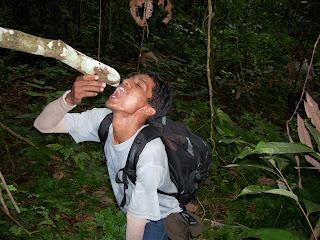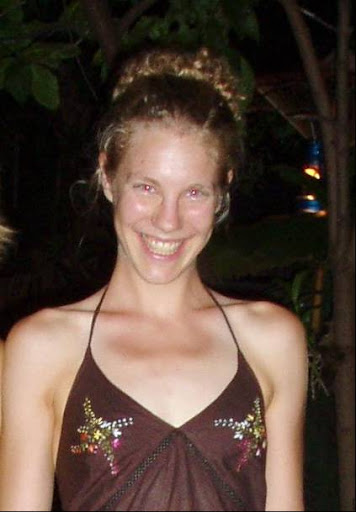After spending an extra day in Ketapang doing paperwork (a truly endless process in this country) Dessy and I followed the rest of the team to
Cali.
First we boarded another, much smaller speed boat to take us up the Pawan river to a town near
Cali.
This boat trip was one of my most unhappy travel experiences to date – I strongly dislike small spaces, and the boat was packed with people to the point that I could barely see outside or move my legs for the entire 4 hour trip. The boat:

After the boat ride was over, we hired a couple of motorbikes and drivers to take us overland to
Cali.
This was to be my first of many harrowing experiences on a motorbike in Ketapang – no helmet, dirt roads, fast driver, and the motorbike loaded with luggage.
But I was able to forget all this as I looked around: Ketapang is filled with bright green hills, red soil, huge fruit trees, wonderful-smelling clean air, abundant streams, birds, and very few people.
I fell in love with the area during this first motorbike ride to
Cali, and I feel so lucky that I will be able to work in the area for the next few years.

Arriving in Cali was like coming home – the whole team warmly welcomed us with enthusiastic greetings and yummy papaya. While in Cali we stayed in the village school (see pic), which was luckily on holiday during our visit. So the first day in the town was filled with setting up house (kitchen, beds, laundry lines, lights) in the school. There is no electricity in Cali except for portable generators. Luckily our neighbors were willing to let us share generator power (for a fee, or course), thus we had lighting and power every evening from about 6-10 pm.

The first night in Cali was full of many firsts – the first time bathing in the river stands out above all other experiences. In Cali, no private bathrooms or bathing areas exist. The small stream that runs through the village is used as a water source (upstream of bathing, etc.), a bathroom, a place to do laundry, and a shower. Every night at about 5 pm most women in Cali go to bathe in the river. Most women wrap a tube sarong around themselves, tie it tightly at the top, and do all bathing activities in this sarong. New to this style of bathing, my sarong kept falling off – probably an unfortunate combination of a small chest and no experience! All the girls had a good laugh at the crazy buleh. Happily, my sarong skills have improved since that first day and I can now bathe without troubles.
After bathing, the entire team went to meet the kepala dusun (literally “head of village”), the man who serves as the leader of Cali. I tried to explain my purpose to him in very broken Indonesian, and then my team members (thank goodness) explained our work in Indonesian. He seemed to support our purpose, and promised to gather a group of villagers to help make a map of the village the following night (“community mapping”).








